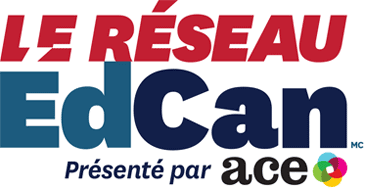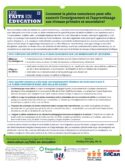Comment la pleine conscience peut-elle soutenir l’enseignement et l’apprentissage aux niveaux primaire et secondaire?
Téléchargez la fiche gratuitement! (659.24 kB / pdf)
Accrochez-la dans votre salle des profs.
TéléchargerCes dix dernières années, les bienfaits de la pleine conscience pour les élèves comme pour les enseignants ont suscité un intérêt accru pour cette pratique en milieu scolaire. La pleine conscience est la capacité de porter son attention entière sur son expérience dans le moment présent. Toutefois, selon une enquête menée par des chercheurs de l’Université de Harvard, notre esprit vagabonde 47 % du temps, ce qui enraye notre capacité de s’axer sur l’ici et maintenant. L’enquête a également révélé qu’un esprit vagabond tend à être un esprit malheureux (c.-à-d. connaissant moins d’émotions positives et un moindre sentiment que la vie a un sens et vaut la peine d’être vécue). Au fil du temps, ce vagabondage mental peut avoir un effet néfaste sur notre résilience, notre apprentissage et notre bienêtre général. Cependant, de récents travaux de recherche ont démontré que la pratique quotidienne de la pleine conscience (p. ex., se concentrer sur sa respiration ou ses mouvements) peut modifier la structure et la fonction du cerveau de façons extrêmement bénéfiques.
VOICI CERTAINS DES EFFETS DE LA PLEINE CONSCIENCE SUR LES ENSEIGNANTS ET LES ÉLÈVES :
Effets sur les enseignants
- Compassion accrue, amélioration des relations avec les élèves et renforcement de la résilience
- Baisse des niveaux de stress, d’anxiété, de dépression et d’épuisement professionnel
Effets sur les élèves
- Amélioration de l’attention, des fonctions exécutives (p. ex., planification, résolution des problèmes, maîtrise de soi, etc.), de la bienveillance, de la compassion, de l’empathie et de la coordination des perspectives
- Amélioration du rendement scolaire et de l’apprentissage socio-émotionnel
- Baisse des niveaux de stress, d’anxiété et de dépression
VOICI QUATRE CONSEILS CLÉS POUR LES ENSEIGNANTS DÉSIREUX DE FAIRE UNE PLACE À LA PLEINE CONSCIENCE DANS LEUR SALLE DE CLASSE :
1. Commencez par vous-même. Lorsque les enseignants s’engagent à pratiquer personnellement la pleine conscience et l’appliquent à leur enseignement, il y a souvent un effet de ricochet positif dans la classe. La pratique fournit aussi l’expérience incarnée nécessaire pour enseigner et orchestrer la pleine conscience dans le respect des expériences des élèves.
2. Veillez à ce que les pratiques de pleine conscience soient présentées dans un contexte de laïcité. En présentant des pratiques de pleine conscience fondées sur la recherche, on s’assure que l’enseignement est conforme aux connaissances scientifiques actuelles et inclut tous les élèves.
3. Proposez des pratiques de pleine conscience tenant compte des traumatismes. Les pratiques de pleine conscience devraient être conçues pour appuyer la sécurité et la stabilité des élèves – en particulier ceux qui souffrent de hauts niveaux de stress ou ont des antécédents de traumatisme.
4. Intégrez la pleine conscience à une démarche pédagogique inclusive et adaptée à la culture. Si l’équité est au centre de la démarche, les enseignants ont de meilleures chances d’être réceptifs aux identités, contextes, antécédents, capacités et besoins des élèves lorsqu’ils élaborent leurs propres pratiques de pleine conscience.
Cultiver la pleine conscience présente des bienfaits autant pour les enseignants que pour les élèves. Lorsque la pleine conscience est intentionnellement intégrée à l’enseignement et à l’apprentissage, des communautés scolaires entières peuvent enregistrer une amélioration du bien-être, dont une diminution des niveaux de stress et d’épuisement professionnel parmi les enseignants, des relations enseignants-élèves plus positives et de meilleurs résultats d’apprentissage pour les élèves.
Autre Ressources Informatives
EN ANGLAIS SEULEMENT
Murphy, S. (2019). Fostering Mindfulness: Building skills that students need to manage their attention, emotions, and behavior in classrooms and beyond. Markham, ON: Pembroke Publishers.
Greater Good in Education (GGIE) of the University of California, Berkeley offers free research-based and informed strategies and practices for the social, emotional, and ethical development of students, for the well-being of the adults who work with them, and for cultivating positive school cultures.
Edutopia is a website and online community dedicated to sharing evidence and practitioner-based learning strategies for educating the whole child in K-12 classrooms.
UCLA Mindfulness Awareness Research Centre (MARC) is a centre devoted to fostering mindful awareness across the lifespan through education and research. There are a number of free guided mindfulness practices on this page.
Trauma-Sensitive Mindfulness is a website (created by Trauma-Sensitive Mindfulness expert David Treleaven, PhD) devoted to resources for learning how to teach and lead mindfulness with an understanding of trauma.
Collaborative for Academic, Social, and Emotional Learning (CASEL) is a source for knowledge about high-quality, evidence-based social and emotional learning (SEL).
The Handbook of Mindfulness in Education is a publication that addresses the science and educational uses of mindfulness in schools.
Mindfulness Journal is a peer-reviewed journal that publishes papers that examine the latest research findings and best practices in mindfulness.
The Best Meditation Apps of 2019 is a list of 12 Mindfulness Apps rated the best of 2019 based on quality, reliability, and reviews. (All but one have a free version).
Références
EN ANGLAIS SEULEMENT
American Mindfulness Research Association (2020). “Figure 1. Mindfulness journal publications by year, 1980-2019”. Repéré à : from American Mindfulness Research Association website. https://goamra.org/resources/
Abenavoli, Rachel & Jennings, Patricia & Harris, Alexis & Greenberg, Mark & Katz, Deirdre. (2013). The protective effects of mindfulness against burnout among educators. The Psychology of Education Review. ISSN 0262-4087.
Black, D. S., & Fernando, R. (2014). Mindfulness Training and Classroom Behaviour among Lower Income and Ethnic Minority Elementary School Children. Journal of Child and Family Studies, 23(7), 1242-1246.
Braun, S.S., Roeser, R.W., Mashburn, A.J. et al. (2019). Middle School Teachers’ Mindfulness, Occupational Health and Well-Being, and the Quality of Teacher-Student Interactions. Mindfulness 10, 245–255.
Brown, K. W. & Ryan, R. M. (2003). The Benefits of Being Present: Mindfulness and Its Role in Psychological Well-Being. Journal of Personality and Social Psychology, 84(4), 822– 848.
Caballero, C. Scherer, E., West, M.R, Mrazek, M.D., Gabrieli, C.F.O., & Gabrieli, J.D.E. (2019). Greater Mindfulness is Associated With better Academic achievement in Middle School. Mind, Brain, and Education. 13(3): 157-166.
Cannon, J. (2016). Education as the Practice of Freedom: A Social Justice Proposal for Mindfulness Educators. Purser, R.E., et al (Eds.). In Handbook of Mindfulness. Switzerland: Springer International Publishing. pp. 397-409.
DeMauro, A.A., Jennings, P.A., Cunningham, T. et al. (2019). Mindfulness and Caring in Professional Practice: an Interdisciplinary Review of Qualitative Research. Mindfulness 10, 1969–1984.
Eva, A. & Thayer, N. (2017). The Mindful Teacher: Translating Research into Daily Well-Being. The Clearing House. Vol .90, No. 1, pp. 18-25.
Feuerborn, L.L., Gueldner, B. (2019). Mindfulness and Social-Emotional Competencies: Proposing Connections through a Review of the Research. Mindfulness, 10, 1707–1720.
Flook, L., Goldberg, S. B., Pinger, L., & Davidson, R. J. (2015). Promoting prosocial behavior and self-regulatory skills in preschool children through a mindfulness-based kindness curriculum. Developmental Psychology, 51(1), 44–51.
Flook, L., Goldberg, S., Pinger, L., Bonus, K., & Davidson, R. (2013). Mindfulness for Teachers: A Pilot Study to Assess Effects on Stress, Burnout, and Teaching Efficacy. International Mind, Brain, and Education. 7(3): 182-195.
Flook, L., Susan L. Smalley, M. Jennifer Kitil, Brian M. Galla, Susan Kaiser-Greenland, Jill Locke, Eric Ishijima, and Connie Kasari. (2010). “Effects of Mindful Awareness Practices on Executive Functions in Elementary School Children.” Journal of Applied School Psychology, 26: 70–95.
Fritz M.M., Walsh L.C., Lyubomirsky S. (2017) Staying Happier. In: Robinson M., Eid M. (eds) The Happy Mind: Cognitive Contributions to Well-Being. Springer, Cham.
Greenberg M., Brown J, & Abenavoli R. (2016). Teacher Stress and Health: Effects on Teachers, Students, and Schools. Social emotional learning. The Pennsylvania State University, Issue Brief, 1-12.
John Meiklejohn, Catherine Phillips, M. Lee Freedman, Mary Lee Griffin, Gina Biegel, Andy Roach, Jenny Frank, Christine Burke, Laura Pinger, et al. (2012). Integrating Mindfulness Training into K-12 Education: Fostering the Resilience of Teachers and Students. Mindfulness, 3, 291-307.
Killingsworth, M. A., & Gilbert, D. T. (2010). A Wandering Mind Is an Unhappy Mind. Science, 330(6006): 932.
Leyland, A., Rowse, G., & Emerson, L. (2018). Experimental Effects of Mindfulness Inductions on Self-Regulation: Systematic Review and Meta-Analysis. Emotion, 1-15.
MacDonald, H.Z. & Price, J.L. (2017) Emotional Understanding: Examining Alexithymia as a Mediator of the Relationship Between Mindfulness and Empathy. Mindfulness, 8(6): 1644-1652.
Magee, R. V. (2019). The Inner Work of Racial Justice: Healing Ourselves and Transforming Our Communities Through Mindfulness. New York, NY: Penguin Random House.
Murphy, S. (2019). Fostering Mindfulness: Building skills that students need to manage their attention, emotions, and behavior in classrooms and beyond. Markham, ON: Pembroke Publishers.
Murphy, S. (2018). Preparing Teachers for the Classroom: Mindful Awareness Practice in Preservice Education Curriculum. In Byrnes, K., Dalton, J. & Dorman, B. (Eds.), Impacting Teaching and Learning: Contemplative Practices, Pedagogy, and Research in Education (pp. 41-51). Lanham, Maryland: Rowman and Littlefield.
Ryan, S. V., von der Embse, N. P., Pendergast, L. L., Saeki, E., Segool, N., & Schwing, S. (2017). Leaving the teaching profession: The role of teacher stress and educational accountability policies on turnover intent. Teaching and Teacher Education, 66, 1–11.
Sibinga, E. M. S., Webb, L., Ghazarian, S. R., & Ellen, J. M. (2016). School-Based Mindfulness Instruction: An RCT. Pediatrics, 137(1), 1-8.
Schonert-Reichl, K. A., Oberle, E., Lawlor, M. S., Abbott, D., Thomson, K., Oberlander, T. F., & Diamond, A. (2015). Enhancing cognitive and social–emotional development through a simple-to-administer mindfulness-based school program for elementary school children: A randomized controlled trial. Developmental Psychology, 51(1), 52-66.
Treleaven, D.A. (2018). Trauma-Sensitive Mindfulness: Practices for safe and transformative healing. New York, NY: W. W. Norton & Company, Inc.
Zarate, K. Maggin, D.M., & Passmore, A. (2018). Meta-analysis of mindfulness training on teacher well-being. Journal of Child Psychology and Psychiatry. 56(10): 1700-1715.
MERCI À NOS GÉNÉREUX PARTENAIRES :
* Dans ce document, le masculin est employé comme genre neutre.


